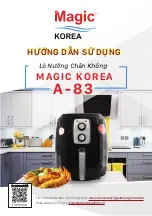
4
and 15 cm rear, and equipped with
factory-supplied 15 cm adjustable
legs or 13 cm casters.
2.5 AIR SUPPLY & VENTILATION:
Keep the area around the fryer clear to
prevent obstruction of combustion and
ventilation air flow as well as for service and
maintenance.
a.
Do not connect this fryer to an exhaust
duct.
b.
Correct installation and adjustment
will ensure adequate air flow to the
fryer system. Proper input is 2m
3
per
hour per kW for gas supplied.
c.
A commercial, heavy-duty fryer must
vent its combustion wastes to the
outside of the building. It is essential
that a deep fat fryer be set under a
powered exhaust hood or that an
exhaust fan be provided in the wall
above the unit, as exhaust gas
temperatures are approximately 427-
538°C(800-1000°F). Check air
movement during installation. Strong
exhaust fans in the exhaust hood or in
the overall air conditioning system can
produce slight air drafts in the room.
d.
Do not place the fryer’s flue outlet
directly into the plenum of the hood,
as it will affect the gas combustion of
the fryer.
e.
Never use the interior of the fryer
cabinet for storage or store items on
shelving over or behind the fryer.
Exhaust temperatures can exceed
425ºC and may damage or melt items
stored in or near the fryer.
f.
Adequate distance must be maintained
from the flue outlet of the fryer(s) to
the lower edge of the filter bank. A
minimum of 45 cm should be
maintained between the flue(s) and the
lower edge of the exhaust hood filter.
g.
Filters and drip troughs should be part
of any industrial hood, but consult
local codes before constructing and
installing any hood. The duct system,
the exhaust hood and the filter bank
must be cleaned on a regular basis and
kept free of grease.
2.6
ALTITUDE:
The fryer input rating (in m
3
/hr) is for
elevations up to 610 m. For elevations
above 610m, the rating should be reduced
four percent (4%) for each additional 305
m above sea level.
The correct orifices are installed at the
factory if operating altitude is known at
time of the customer’s order.
2.7
RECEIVING AND UNPACKING
:
Check that the container is upright.
Unpack the fryer carefully and remove all
accessories from the carton. Do not
discard or misplace these, as they will be
needed.
After unpacking, immediately check the
equipment for visible signs of shipping
damage. If such damage has occurred,
contact the carrier and file the appropriate
freight claims. Do not contact the factory,
as the responsibility of shipping damage
is between the carrier and the dealer or
end-user.
If your equipment arrives damaged:
a.
File claim for damages immediately,
regardless of extent of damage.
b.
Visible loss or damage: Be sure this
is noted on the freight bill or express
receipt and is signed by the person
making the delivery.
c.
Concealed loss or damage: If damage
is unnoticed until equipment is
unpacked, notify freight company or
carrier immediately, and file a
concealed damage claim. This should
be done within fifteen (15) days of
date of delivery. Be sure to retain
container for inspection.
NOTE:
Dean Does Not Assume Responsibility
For Damage Or Loss Incurred In
Transit.
Summary of Contents for D50 Series
Page 12: ...Gas Valve Adjustments ...






































